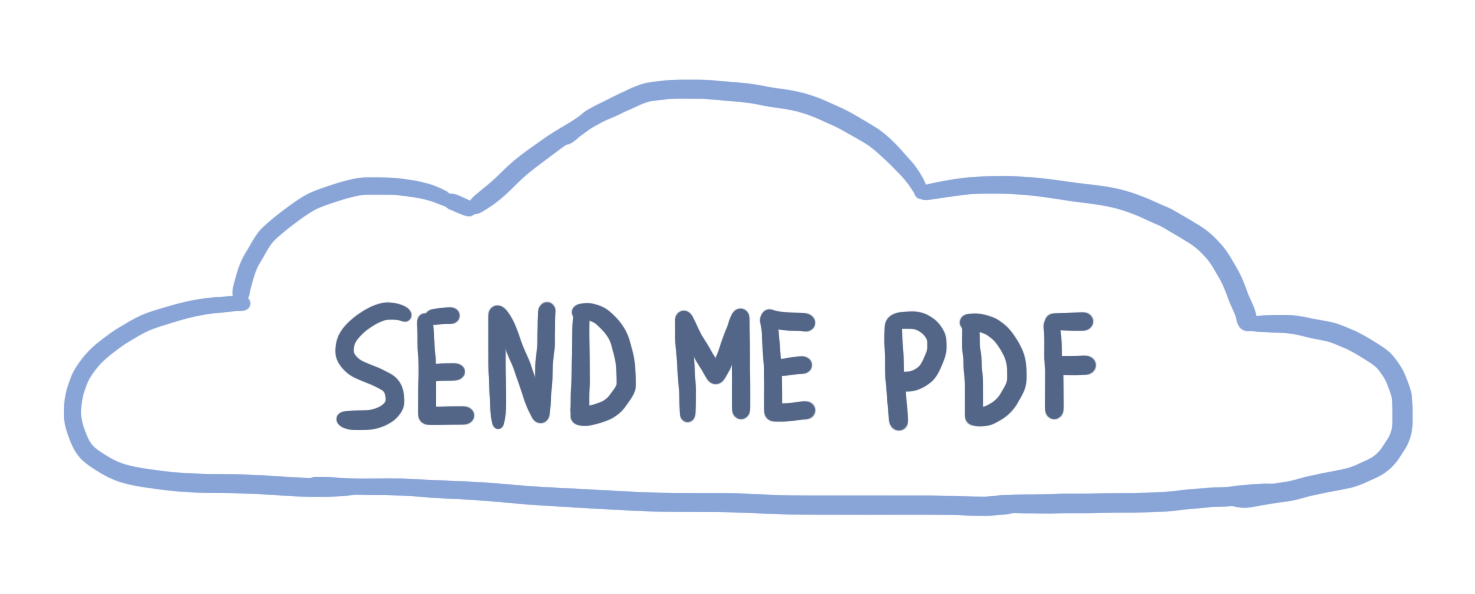Do you know there is a simple way to use Slack for Project Management and automate most of the processes?
Yes, it's now possible! Clear for takeoff ✈️
✓
In this guide, we'll walk through the most effective project management practices and explain how to run them directly from Slack.
For each project management process, you'll find a step-by-step instruction on how to automate them using Slack and Standuply Slack App.
It took us four years to build it all. With so many features onboard, we see a need for the full guide on using Slack for Project Management with Standuply.
Standuply can save hundreds of hours for you and your team. Proven by thousands of happy customers.
See our customer stories by some of them.
It took us four years to build it all. With so many features onboard, we see a need for the full guide on using Slack for Project Management with Standuply.
Standuply can save hundreds of hours for you and your team. Proven by thousands of happy customers.
See our customer stories by some of them.

What is Standuply?
Standuply is the best Project Management app for Slack used by thousands of teams like Slack itself, IBM, Google to automate their unique workflows. However, there are several repetitive patterns across many teams. These are the three most popular automation workflows among Standuply customers.
1
Replacement of physical standup meetings altogether
You'd be surprised to know how many developers hate standup meetings and even underestimate the importance of Slack in project management.
For some of them think, it's a distraction, others don't like talking much. Overall, an easy-going process becomes a hurdle for the average development team.
In addition, when a team is remote scheduling standup meetings could be a pain in the calendar. Since remote work is a popular trend nowadays, many teams start to feel that pain.
The solution is easy and elegant: replace a standup meeting via a scheduled survey on Slack. Standuply does that perfectly with customized questions, flexible scheduling options, and integrations.
As a result, team-members receive daily updates in their #standup Slack channel without being distracted. Being asynchronous fits every remote worker keeping them motivated. And that's why Standuply is the best project management app for Slack.
For some of them think, it's a distraction, others don't like talking much. Overall, an easy-going process becomes a hurdle for the average development team.
In addition, when a team is remote scheduling standup meetings could be a pain in the calendar. Since remote work is a popular trend nowadays, many teams start to feel that pain.
The solution is easy and elegant: replace a standup meeting via a scheduled survey on Slack. Standuply does that perfectly with customized questions, flexible scheduling options, and integrations.
As a result, team-members receive daily updates in their #standup Slack channel without being distracted. Being asynchronous fits every remote worker keeping them motivated. And that's why Standuply is the best project management app for Slack.
2
Partial replacement of physical standup meetings
Keeping a personal touch and high morale in a Agile team is essential. It's one of the purposes of a standup meeting.
As mentioned above having a meeting every single day could be overhead. But at the same time, it's crucial to update everyone on a team on a daily basis.
Some teams decide to run 2-3 physical standup meetings a week and automate others via Slack using Slanduply. The additional benefit of that approach is that Standuply saves a history of all the meetings to be explored later (if needed).
For example, we at Standuply have meetings via Slack from Mon to Thu and on Friday we gather together for online standup meeting via Zoom.
As mentioned above having a meeting every single day could be overhead. But at the same time, it's crucial to update everyone on a team on a daily basis.
Some teams decide to run 2-3 physical standup meetings a week and automate others via Slack using Slanduply. The additional benefit of that approach is that Standuply saves a history of all the meetings to be explored later (if needed).
For example, we at Standuply have meetings via Slack from Mon to Thu and on Friday we gather together for online standup meeting via Zoom.
3
Partial replacement of physical standup meetings
Developers often come unprepared to standup meetings. We don't mean to be fully prepared, but at least to think a bit prior to a meeting of current tasks/obstacles. Few people do that. It leads to longer meetings and unnecessary discussions.
By the way, it's one more reason developers dislike standup meetings.
There is a simple and yet powerful solution. Standuply surveys team-members in Slack and then delivers a brief report just before the offline standup meeting.
This way people start thinking about their progress beforehand and all members can skim through the answers and prepare their questions or comments.
As a result, a standup meeting goes quickly and straight to the point.
By the way, it's one more reason developers dislike standup meetings.
There is a simple and yet powerful solution. Standuply surveys team-members in Slack and then delivers a brief report just before the offline standup meeting.
This way people start thinking about their progress beforehand and all members can skim through the answers and prepare their questions or comments.
As a result, a standup meeting goes quickly and straight to the point.
Unfasten seat belts and enjoy the flight.
We are ready to dive deeper into how to set project management processes on autopilot in Slack
which wasn't possible before.
We are ready to dive deeper into how to set project management processes on autopilot in Slack
which wasn't possible before.
Feature #2
Feature #1
Feature #4
Feature #3
Feature #5
Feature #7
Feature #6
Feature #10
Feature #8
Feature #12
Feature #9
Feature #11
Feature #1



Learn how to use stand-up meetings in Slack for perfect Project Management
Agile teams run standup meetings every day, always at the same time, most often at the beginning of the day. Here comes the question: what to say in a standup meeting?
Scrum Master (meeting host) asks three questions that each member of the meeting must answer. They may sound different, but the essence should remain the same:
— What did you do yesterday?
— What do you plan to do today?
— Do you have any obstacles?
The standup meeting is time-boxed to 15 minutes. All the discussions longer than a minute or where only a few members are needed should be scheduled as a separate meeting. Daily standup should be quick to inform everyone on the team's progress and potential obstacles.
Overall, standup meetings have three purposes: focus, accountability, motivation. When done right, it's a great practice that improves a team's productivity.
Want to quickly learn about Scrum? Here's the great video about it:
Scrum Master (meeting host) asks three questions that each member of the meeting must answer. They may sound different, but the essence should remain the same:
— What did you do yesterday?
— What do you plan to do today?
— Do you have any obstacles?
The standup meeting is time-boxed to 15 minutes. All the discussions longer than a minute or where only a few members are needed should be scheduled as a separate meeting. Daily standup should be quick to inform everyone on the team's progress and potential obstacles.
Overall, standup meetings have three purposes: focus, accountability, motivation. When done right, it's a great practice that improves a team's productivity.
Want to quickly learn about Scrum? Here's the great video about it:
Setting up stand-up meetings with Standuply
Standuply has several automation options to improve your virtual stand-up meetings. We call those automation 'reports'. You can configure your own report or choose any of the predefined options.
You can choose the column you need from all Standuply report section.
See all the parameters by which reports are sorted, highlighted in the screenshot below:
See all the parameters by which reports are sorted, highlighted in the screenshot below:
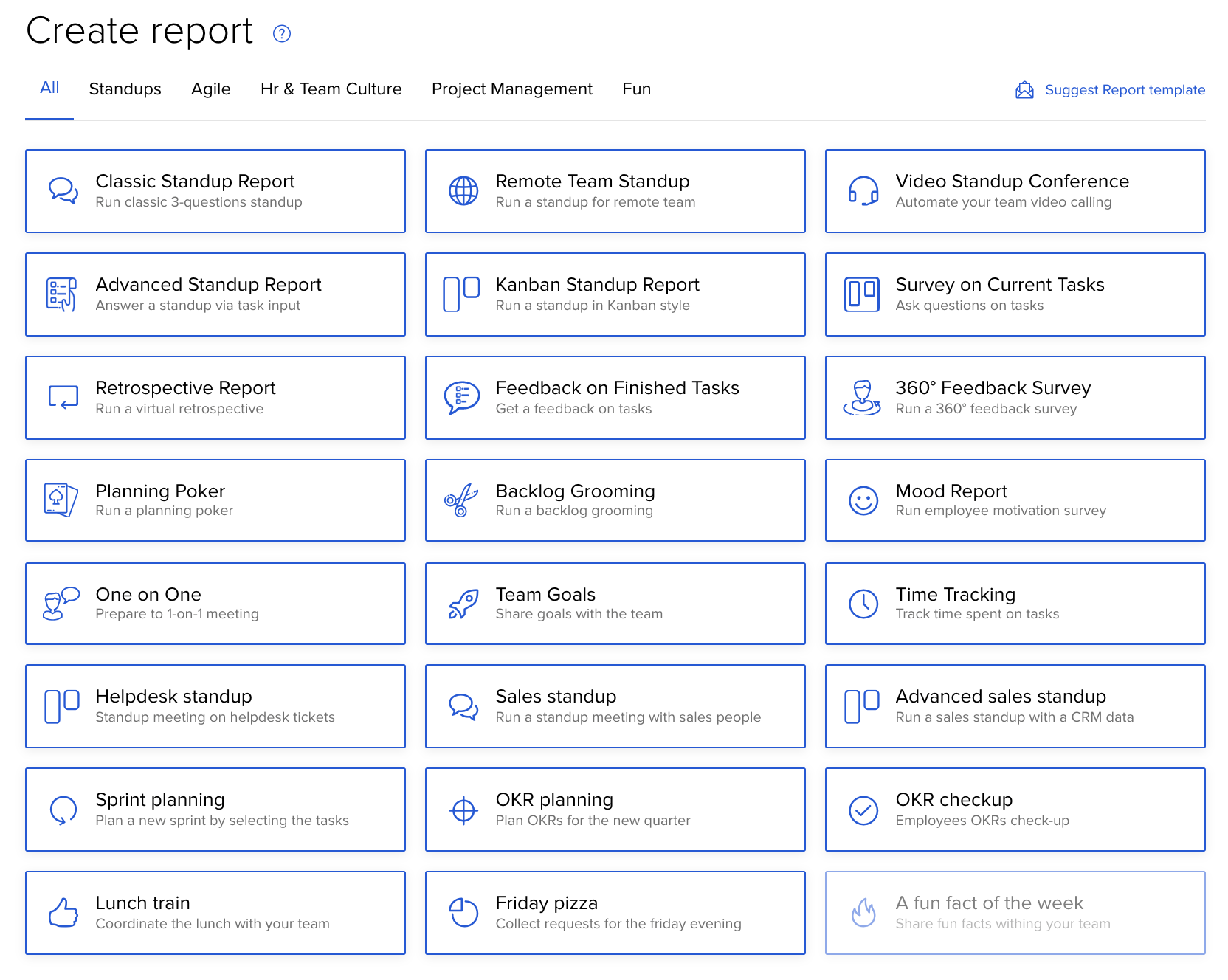

Now let's dig deeper into how you can effectively use Slack for Project Management starting from the "Standups" section.
Classic Standup Report
This is a classic way of running a standup meeting with the three questions (however, you can change them if you like).
1. Pick a schedule and people to ask and then Standuply reaches out to selected people.
1. Pick a schedule and people to ask and then Standuply reaches out to selected people.
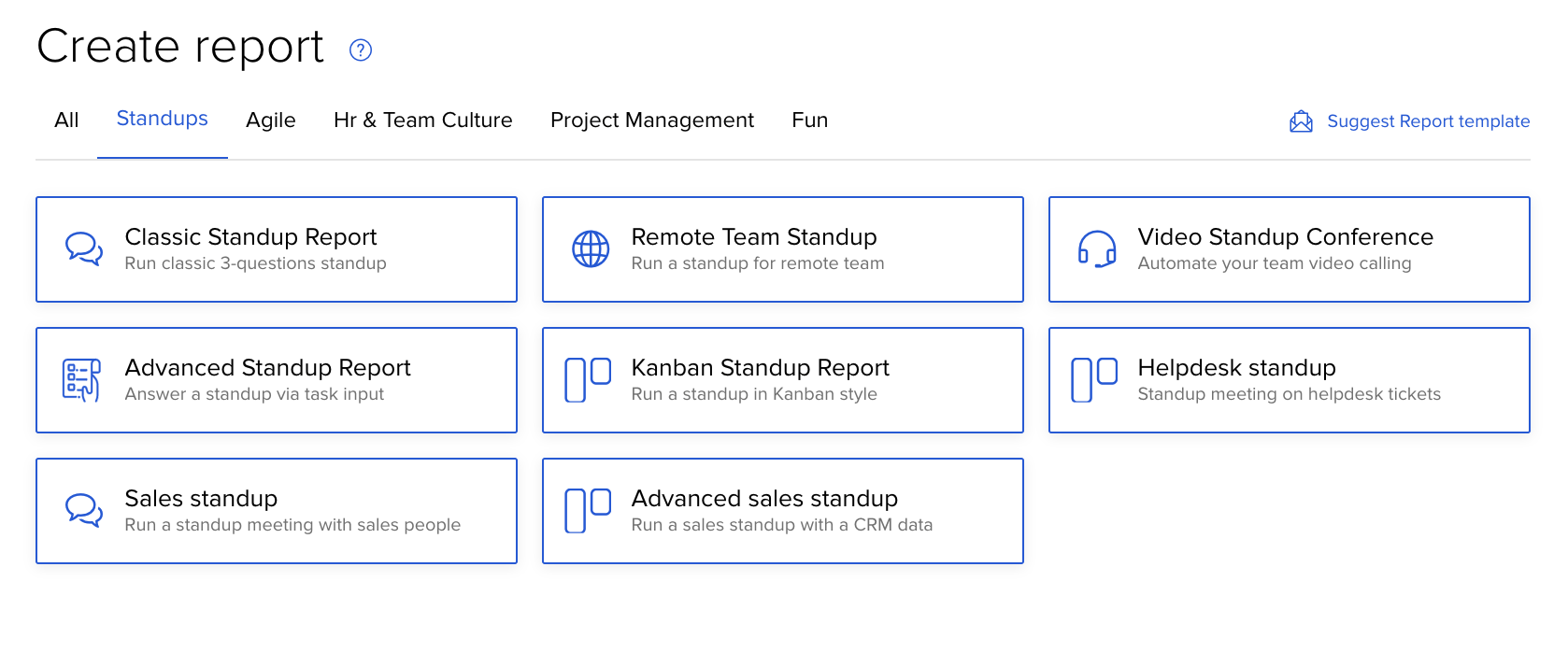
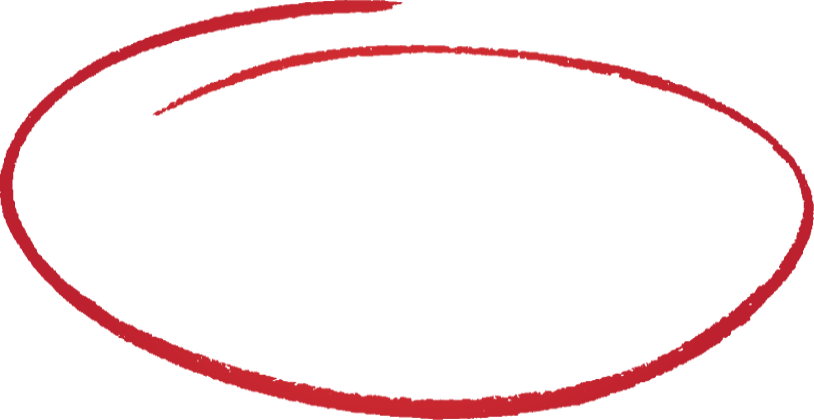
2. Survey them asking questions you set up.
3. Once the process is over, Standuply serves an aggregated report in a Slack channel.
3. Once the process is over, Standuply serves an aggregated report in a Slack channel.
See how it looks like in Slack:
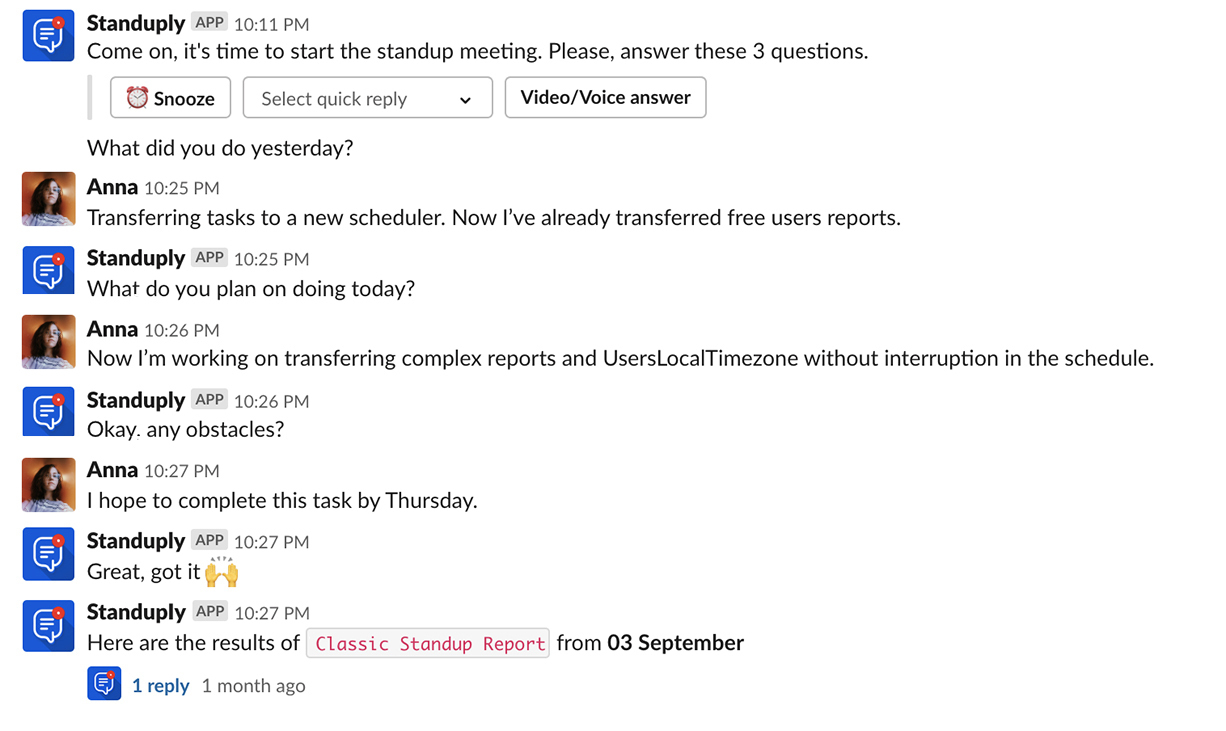
Advanced Standup Report
This way of running a standup has an additional option to answer questions with a task input from your task tracker. Such an option appears when you choose a 'task response' from a dropdown menu near a corresponding question.

1. Сonnect Standuply to your task tracker. We have integrations with JIRA, Trello, Asana HubSpot, GitHub, and Pivotal or you can create your own integration using Custom Endpoint.
2. Define a list of tasks to be included in the question.
3. Then a person will be able to choose a task from a list as an answer.
Using Standuply Integrations for Slack project management you can build your team that way that your teammates will have a float time for some tasks.
2. Define a list of tasks to be included in the question.
3. Then a person will be able to choose a task from a list as an answer.
Using Standuply Integrations for Slack project management you can build your team that way that your teammates will have a float time for some tasks.
In Slack the process looks like:
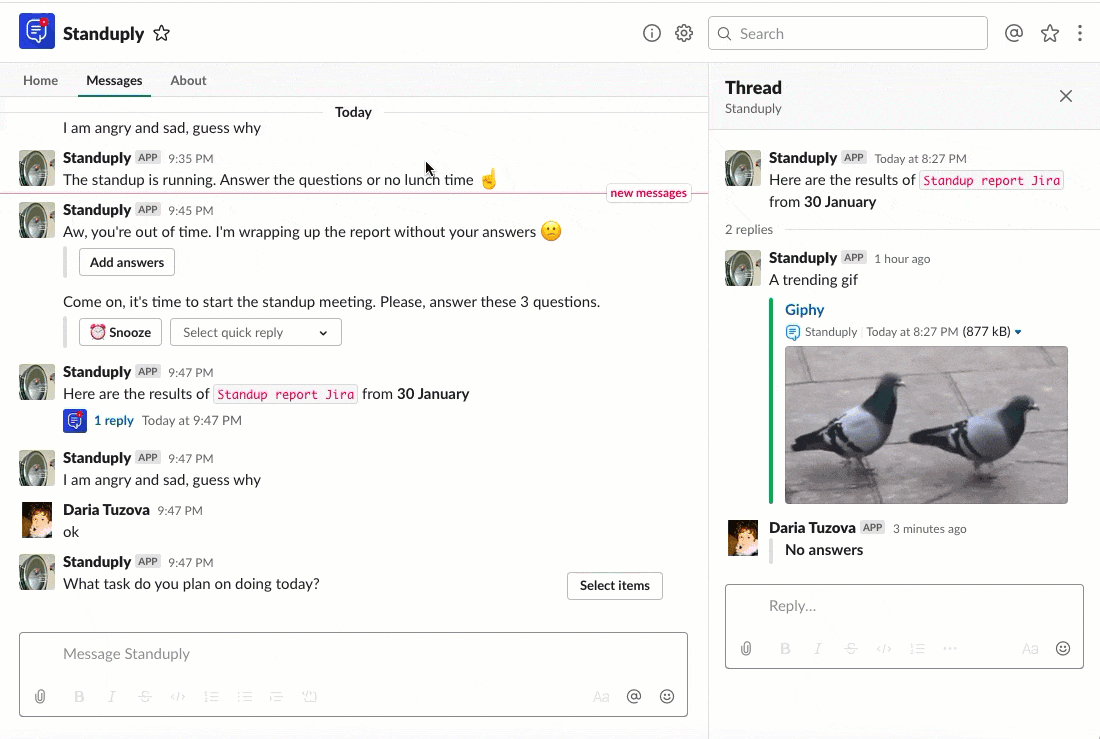
Remote Team Standup
We designed this report type for teams distributed among different time zones.
When you define a schedule, you'll see 'User's local time zone' in the Time zone configuration. With that option, Standuply surveys every person in a report based on their local time.
When you define a schedule, you'll see 'User's local time zone' in the Time zone configuration. With that option, Standuply surveys every person in a report based on their local time.


Let's say you have a standup at 9 am with team folks from San Francisco, London, and Tokyo. So Standuply will reach out to all of them when it's 9 am in their cities. And no need to wake up in the middle of the night to sent the report.
Kanban Standup Report
This automation represents a different flow. Here Standuply asks selected people about specified inputs (tasks, in that case).
Think of it as the Advanced Standup Report combined with the Kanban board. Kanban focuses on reducing the amount of work in progress. Its goal to move tasks from start to done as fast as possible.
Aren't familiar with Kanban? Here's the short video explaining it in detail.
Think of it as the Advanced Standup Report combined with the Kanban board. Kanban focuses on reducing the amount of work in progress. Its goal to move tasks from start to done as fast as possible.
Aren't familiar with Kanban? Here's the short video explaining it in detail.
You choose a list of tasks to be asked about, but the questions are different compared to the Classic Standup. According to Kanban, questions are focused on the specific details for each task.

See how it looks like in Slack:
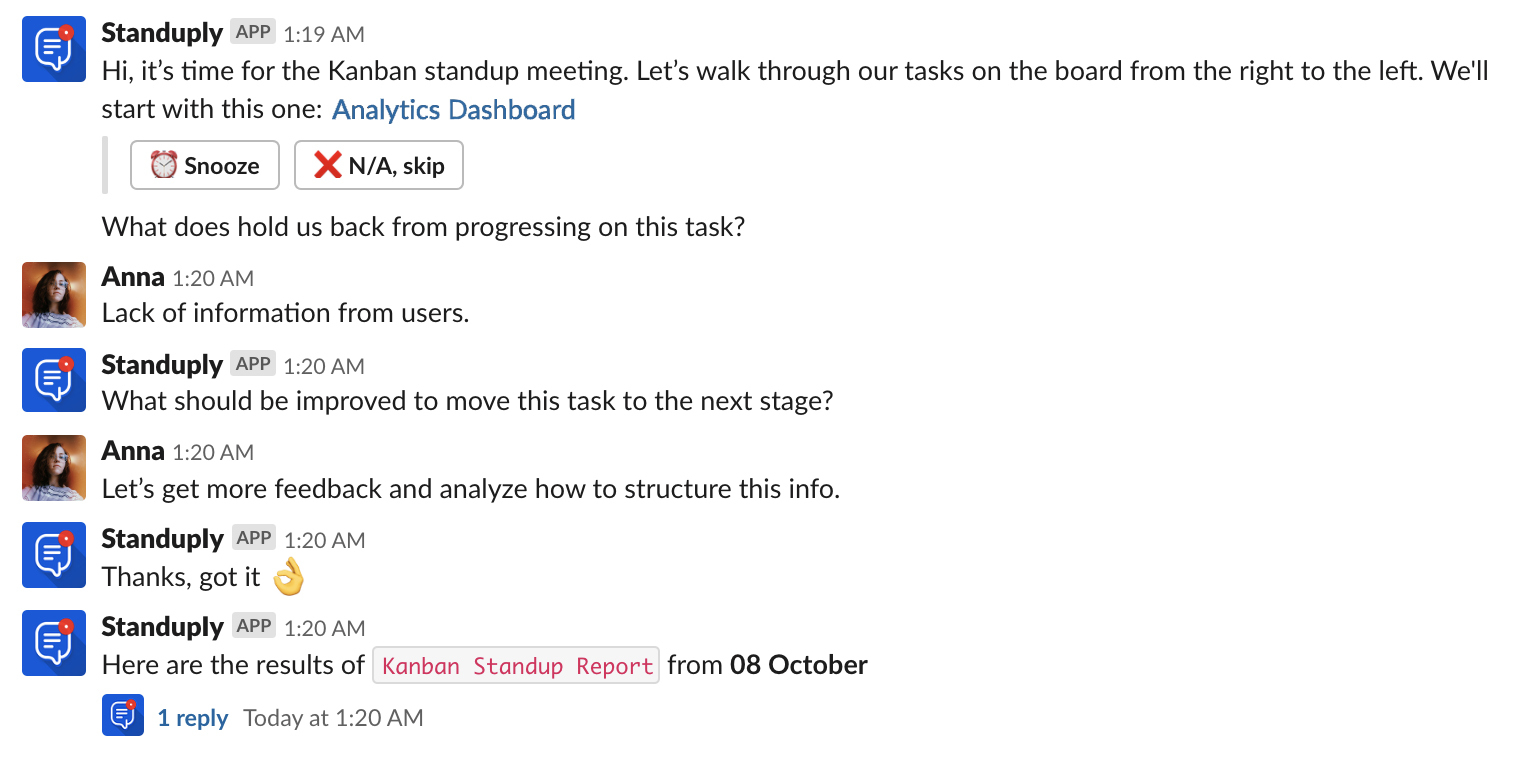
Feature #2


See how to use Slack for Retrospective improve your Project Management
A retrospective is a meeting held at the end of a Sprint to discuss what was done right and what can be improved. This meeting can drastically improve the development process of an Agile team, especially if the team is distributed.
A retrospective provides an opportunity for a team to look back and inspect its productivity. The role of scrum master is making sure that the team understands its purpose and holds a meeting on a regular basis.
The goal of the retrospective meeting is to improve the work of the processes. The whole team should decide what they want to:
— start doing in the next Sprint;
— stop doing;
— continue doing;
Using retrospectives, the team comes up with a plan of improvements for the next Sprint.
A retrospective provides an opportunity for a team to look back and inspect its productivity. The role of scrum master is making sure that the team understands its purpose and holds a meeting on a regular basis.
The goal of the retrospective meeting is to improve the work of the processes. The whole team should decide what they want to:
— start doing in the next Sprint;
— stop doing;
— continue doing;
Using retrospectives, the team comes up with a plan of improvements for the next Sprint.
Setting up retrospective meetings with Standuply
Standuply records retrospective feedback from the team during the sprint and then sends it directly to Scrum Master or PM to be discussed during a retrospective meeting.
We have a 'retrospective report' for that purpose in Standuply.
We have a 'retrospective report' for that purpose in Standuply.


1. Define a schedule. We recommend running a retro once every two weeks on Friday or after a finished sprint.

2. Choose people to ask and type in questions. We have prefilled the set of questions for the retrospective, but feel free to choose whatever works for your team.

See how it looks like in Slack:

By the way, you can use it as a preparation before a physical retrospective meeting or as a replacement for that meeting.

Feature #3

Improve your Project Management by receiving feedback from your team directly in Slack
When the task is done, there is one more thing experienced managers do about it. Their goal is to gather feedback on that particular task: was that engaging, challenging, or boring?
When people work too much on boring tasks, they become demotivated.
If you don't want that on your team, this simple project management process will help. It starts with asking your team members basic questions like "How did you like working on <task>?" or "What tasks would you prefer working on in the future?".
The more advanced way is consistently run such a survey and keep track of team motivation results of every team member.
You may notice that someone starts feeling low about her task. Then it's time to get involved and solve this issue in the next one-on-one meeting.
Sometimes it's just enough to keep track of the overall engagement state on the team. Moreover, you can survey the team not only on finished tasks but on on-going tasks if you feel the progress slows down.
And we know a simple way to use Slack for task management and track all the feedback.
When people work too much on boring tasks, they become demotivated.
If you don't want that on your team, this simple project management process will help. It starts with asking your team members basic questions like "How did you like working on <task>?" or "What tasks would you prefer working on in the future?".
The more advanced way is consistently run such a survey and keep track of team motivation results of every team member.
You may notice that someone starts feeling low about her task. Then it's time to get involved and solve this issue in the next one-on-one meeting.
Sometimes it's just enough to keep track of the overall engagement state on the team. Moreover, you can survey the team not only on finished tasks but on on-going tasks if you feel the progress slows down.
And we know a simple way to use Slack for task management and track all the feedback.

In this very detailed guide, you'll find out how to prioritize tasks and figure out which ones are most appropriate for your project's needs.
Setting up feedback on tasks survey with Standuply
There are two automation reports in Standuply to set it up:'Survey on Current Tasks' and 'Feedback on Finished Tasks'.




Well, the names speak to themselves!
1. As usual, it starts with a schedule and a range of people to ask.
1. As usual, it starts with a schedule and a range of people to ask.
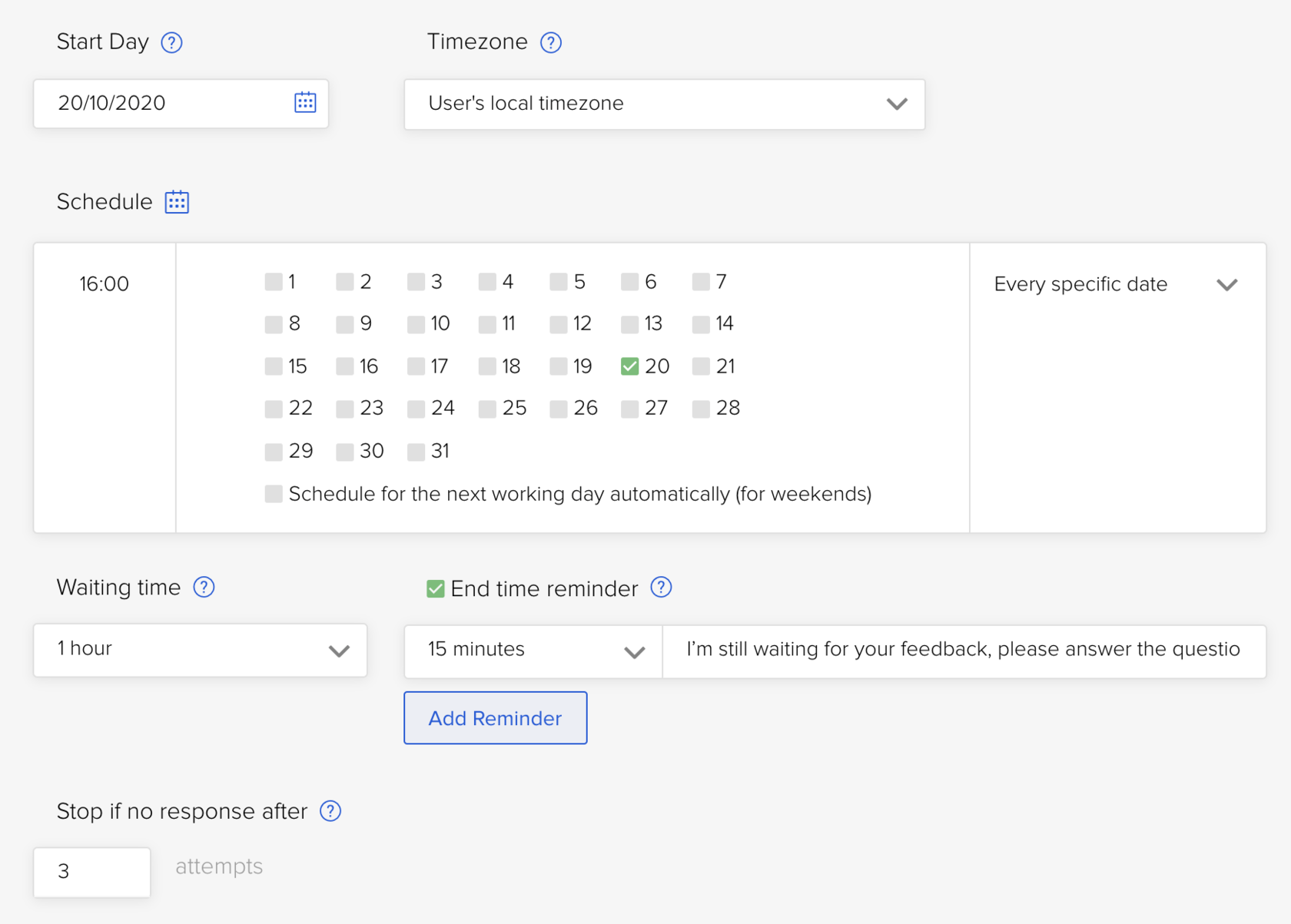
2. Further, you define a list of tasks and a set of questions to ask everyone about those tasks. We have prefilled the set of questions, but feel free to write down whatever works for your team.

See how it looks like in Slack:
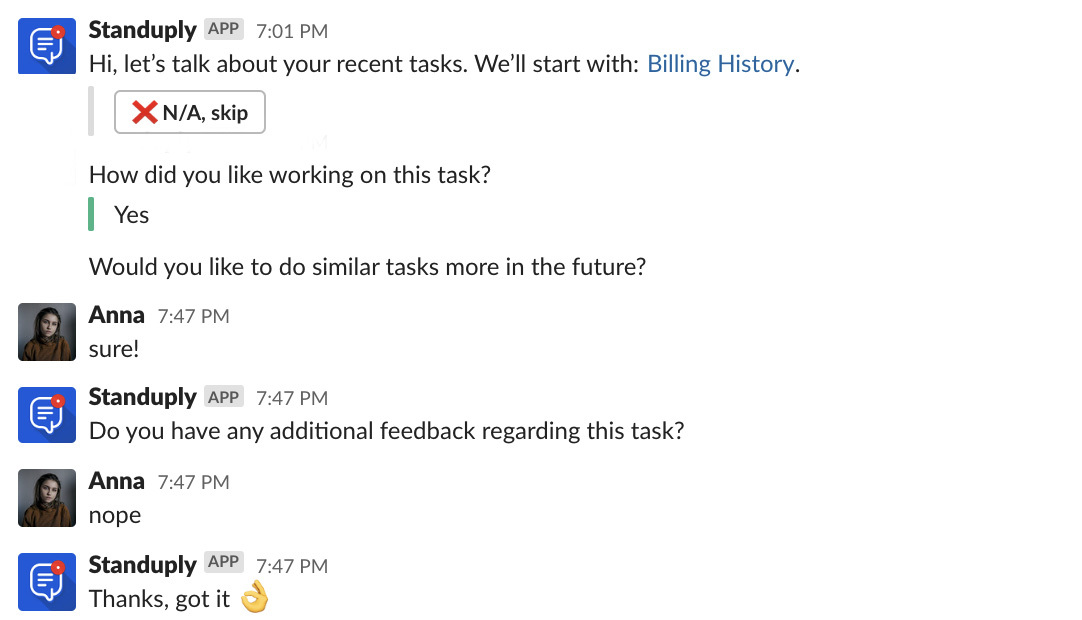

Feature #4

Simple but powerful Project Management process to know your team better
360-degree feedback is a complicated HR project management process of evaluating team-members when everyone provides feedback about each person. It helps to track the motivation and satisfaction levels of every individual in the company.
The 360-degree survey may consist of 5-15 questions about every person on self-awareness, drive for results, leadership, communication, teamwork. It has its pros and cons, though.
Usually, it's done once a quarter and then the results are compared to the previous 360-degree feedback of a certain person. Thus, the greatest value is seen after having at least 3-4 reviews of a particular person.
That's why it's crucial to keep records of all the 360 reviews in the company and run the processes consistently each quarter and it's much easier to run this process in Slack.
Sometimes it's done by the HR manager, but more often we see Product/Project managers running this process on their Scrum teams.
The 360-degree survey may consist of 5-15 questions about every person on self-awareness, drive for results, leadership, communication, teamwork. It has its pros and cons, though.
Usually, it's done once a quarter and then the results are compared to the previous 360-degree feedback of a certain person. Thus, the greatest value is seen after having at least 3-4 reviews of a particular person.
That's why it's crucial to keep records of all the 360 reviews in the company and run the processes consistently each quarter and it's much easier to run this process in Slack.
Sometimes it's done by the HR manager, but more often we see Product/Project managers running this process on their Scrum teams.

Here you can find examples of 360-degree feedback survey questions. And here's the a similar template by Surveymonkey.
Setting up 360-degree feedback with Standuply
Choose the '360 Feedback Surveys" template and let's move on.


You'll see that it's set up to run once a quarter (as we do), but you can change it if you need a process to run more often.

Keep in mind, that a 360-degree survey is quite a long one. We recommend increasing the number of failed attempts to ensure everyone will find time to fill out the survey. As a default, we set it up for 15 attempts.
It means that starting from the 1st day of the survey if the user hasn't provided their answers, Standuply will get back to that person on the next day. The process will continue until either the person provided the answers or the number of attempts is over.
On the second step, choose people to ask and the set of inputs to ask about. In this scenario, it will be people. So, first, you select survey participants and then a list of people to evaluate.
It means that starting from the 1st day of the survey if the user hasn't provided their answers, Standuply will get back to that person on the next day. The process will continue until either the person provided the answers or the number of attempts is over.
On the second step, choose people to ask and the set of inputs to ask about. In this scenario, it will be people. So, first, you select survey participants and then a list of people to evaluate.
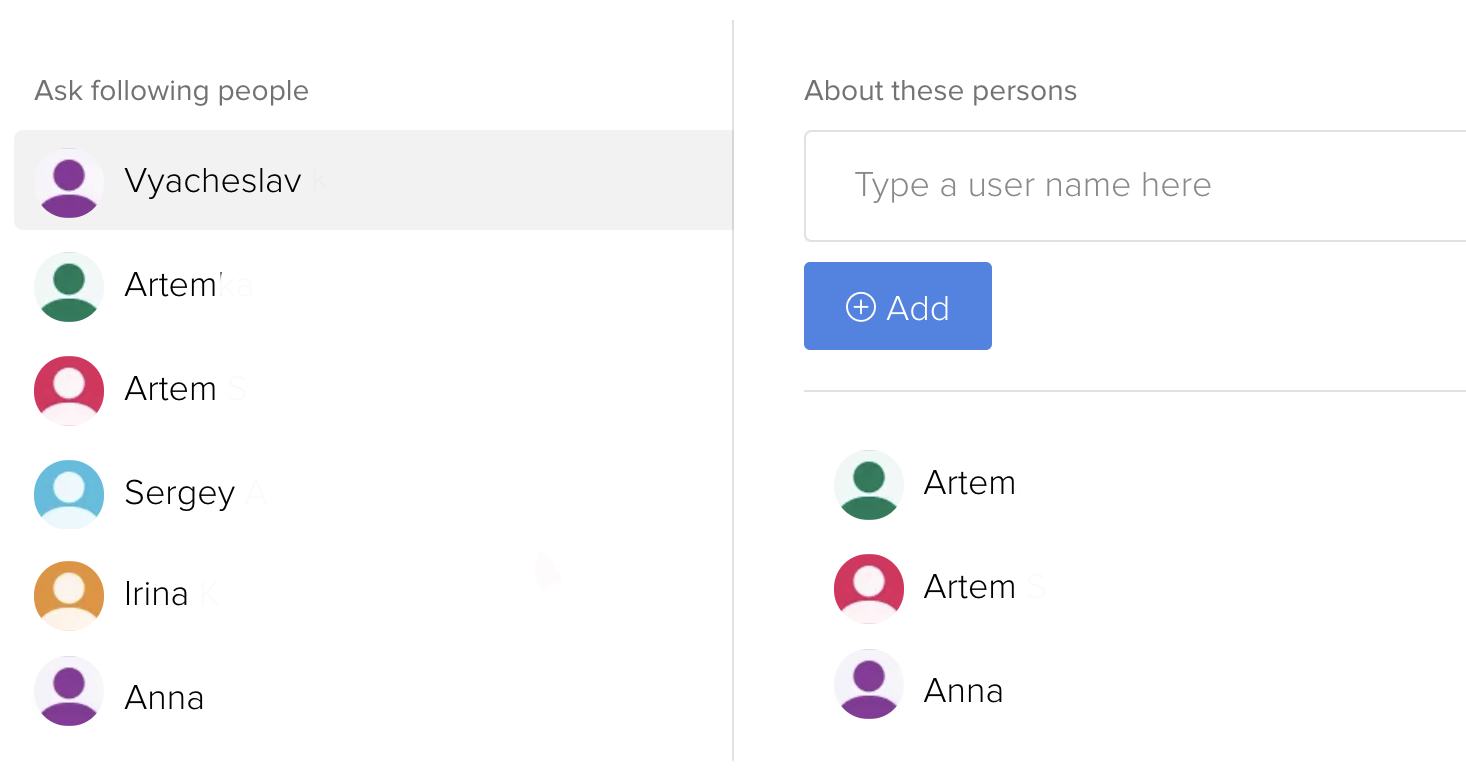
Then define questions to ask about each person. As usual, we have prefilled the set of questions. Some questions in 360 review include conditional answers. It means that depending on the respondent's feedback Standuply will ask additional questions if needed. Of course, you can customize every question and answer for your team.

See how it looks like in Slack:
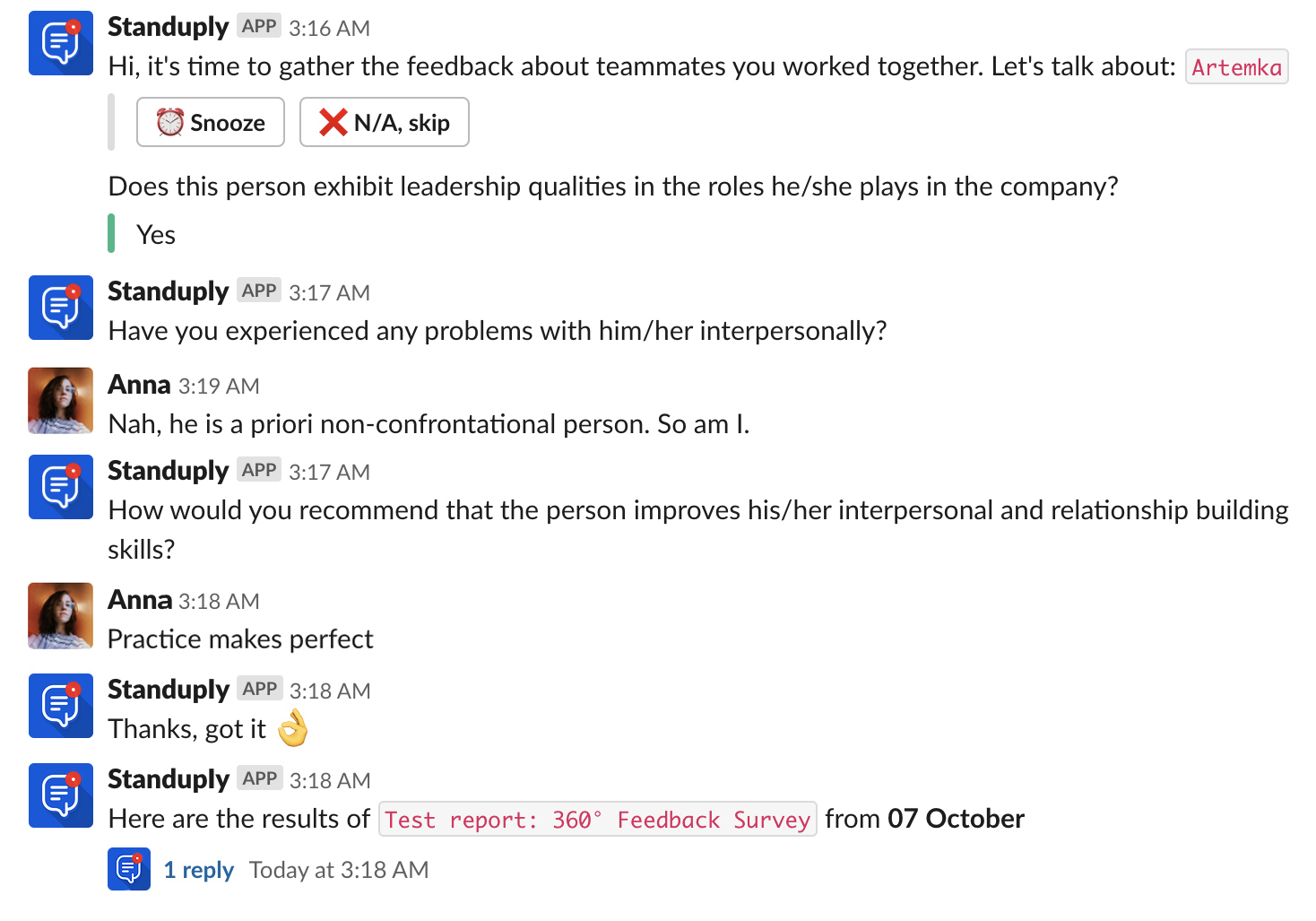

Feature #5
Spread out the cards to prioritize tasks in Slack to manage your future work
Planning Poker is a powerful estimation Agile technique used in project management which is incredibly easy to perform in Slack with Standuply. It's used to find out how much a priority task is for a particular person.
The aim of Planning Poker is to bring everyone in your Scrum together around the table to achieve agile project management goals.
It helps them quickly come to an agreement on each task estimation with story points, days, or any other estimating unit. Sometimes teams use special poker cards, so this Scrum process looks like playing a game.
Here's a good read with details on Planning Poker. Another one by Mike Cohn is here.
As a consensus-based technique, Planning Poker involves all the Scrum team members. Every person blindly provides their task estimation according to the Fibonacci sequence (0, 1, 2, 3, 5, 8, 13, 21, 34, 55, etc). Then estimations are revealed and compared.
If all estimators selected the same value, that becomes the estimate. If not, the team discusses their estimates. The high and low estimators should especially share their reasons. Then the process runs again until all estimators provide the same estimate.
Planning Poker technique ensures there is no one person whose opinion effects on others. Everyone has their own vote and understands what is the definition of responsibility.
The aim of Planning Poker is to bring everyone in your Scrum together around the table to achieve agile project management goals.
It helps them quickly come to an agreement on each task estimation with story points, days, or any other estimating unit. Sometimes teams use special poker cards, so this Scrum process looks like playing a game.
Here's a good read with details on Planning Poker. Another one by Mike Cohn is here.
As a consensus-based technique, Planning Poker involves all the Scrum team members. Every person blindly provides their task estimation according to the Fibonacci sequence (0, 1, 2, 3, 5, 8, 13, 21, 34, 55, etc). Then estimations are revealed and compared.
If all estimators selected the same value, that becomes the estimate. If not, the team discusses their estimates. The high and low estimators should especially share their reasons. Then the process runs again until all estimators provide the same estimate.
Planning Poker technique ensures there is no one person whose opinion effects on others. Everyone has their own vote and understands what is the definition of responsibility.
Setting up Planning Poker via Standuply
Click on the 'Planning Poker' template when creating a report in Standuply and pick a schedule based on your workflow.


You can run that process after the Sprint planning meeting to let the team evaluate the tasks asynchronously.
After that, you choose people to ask and tasks to evaluate. It's done as a survey with different estimation options. Feel free to tweak it according to your needs.
After that, you choose people to ask and tasks to evaluate. It's done as a survey with different estimation options. Feel free to tweak it according to your needs.

Once the process is over, you will have survey results in Slack. The team can discuss it if provided estimations differ a lot.
See how it looks like in Slack:
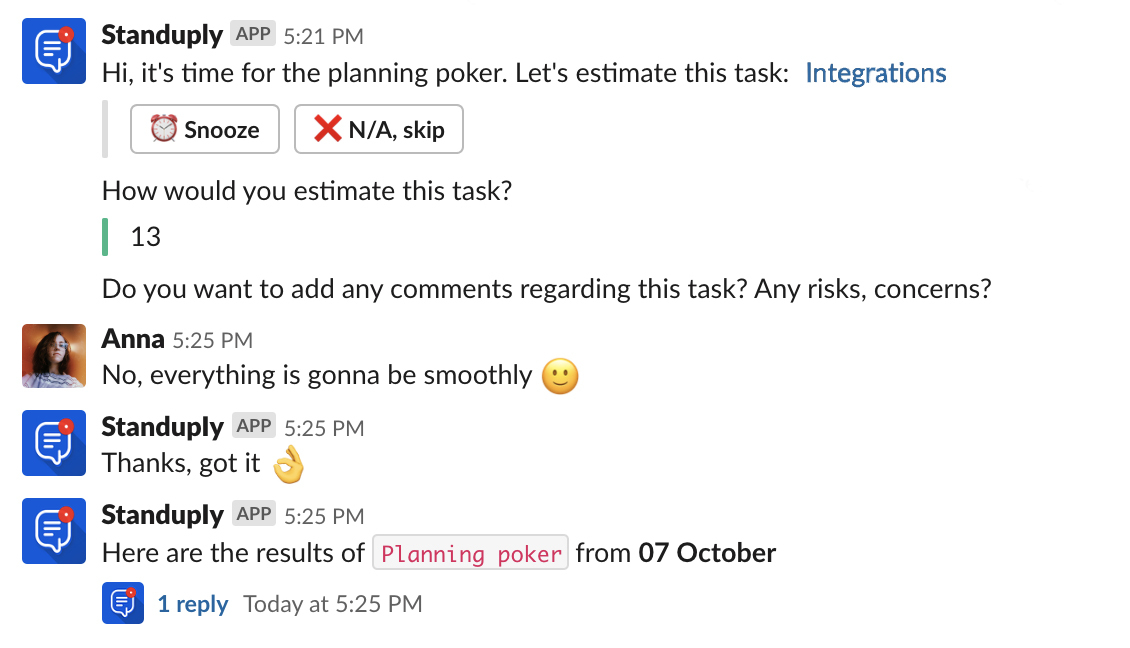

Feature #6
Brush your backlog from non priority tasks directly from Slack
Backlog Grooming is an essential Agile process for a team to review and update items in their Sprint product backlog. This activity consists of five steps and occurs on a regular basis in project management and could be a scheduled meeting.
The product owner and the rest of the team get together and run through the Scrum Board together to ensure the backlog contains the appropriate items, they are prioritized and ready to be delivered.
Backlog grooming helps a team avoid rework by not doing what isn't important and always keeping in focus actual sprint plans and things of the top priority. As a result, a team moves quicker and stays highly motivated.
However, when the Scrum Board is digital there are modern ways to do so. Here's how you can run Backlog Grooming using Slack and Standuply.
The product owner and the rest of the team get together and run through the Scrum Board together to ensure the backlog contains the appropriate items, they are prioritized and ready to be delivered.
Backlog grooming helps a team avoid rework by not doing what isn't important and always keeping in focus actual sprint plans and things of the top priority. As a result, a team moves quicker and stays highly motivated.
However, when the Scrum Board is digital there are modern ways to do so. Here's how you can run Backlog Grooming using Slack and Standuply.
Setting up Backlog Grooming via Standuply
Choose the 'Backlog Grooming' template in Standuply for that purpose.


We recommend running this process a few days before the new Sprint planning, especially if your team is distributed. This way your team is able to review the backlog tasks asynchronously with no rush.
To schedule it correctly, there is an option 'Every specific date' on the first step when creating a report in Standuply.
To schedule it correctly, there is an option 'Every specific date' on the first step when creating a report in Standuply.

Сhoose people to ask, tasks to groom and set up questions. We have prefilled the questions for Backlog Grooming but you can create your versions.

When the whole team consistently participates in the processes, you can have all tasks groomed by the date of the next Sprint. Sometimes it's better to select fewer tasks to ask about. In this case, team members more likely will finish the survey.
See how it looks like in Slack:


Feature #7

Simple but powerful Project Management process to know your team better
While 360-degree feedback provides the full picture quarterly, you may want to check the team's mood more often. It's important to keep track of the team's motivation for many reasons. Especially, it's critical to sustain a healthy team culture in a remote team, for example, celebrate your success together even if you're not sitting in the same room.
First, team culture is extremely important part of team work. We're all humans with a different emotional background and motivations. When a person is highly motivated, he/she delivers the best results and energizes the whole team. In contrast, the person feeling depressed may drag the team down and delay the deadlines.
When a team is small, an experienced manager feels the team's vibe. But as the team grows measuring team happiness becomes more complex and lacks consistency. That's where the team motivation survey kicks in.
Sometimes it's enough to track the general climate in the team, rather than personal inputs. Motivation check-up survey acts like team mood barometer and may be anonymous if questions are sensitive. Usually, teams run them once a week or twice a month to keep the rhythm and see the trend.
Standuply eliminates the complexity in that process and makes it consistent.
First, team culture is extremely important part of team work. We're all humans with a different emotional background and motivations. When a person is highly motivated, he/she delivers the best results and energizes the whole team. In contrast, the person feeling depressed may drag the team down and delay the deadlines.
When a team is small, an experienced manager feels the team's vibe. But as the team grows measuring team happiness becomes more complex and lacks consistency. That's where the team motivation survey kicks in.
Sometimes it's enough to track the general climate in the team, rather than personal inputs. Motivation check-up survey acts like team mood barometer and may be anonymous if questions are sensitive. Usually, teams run them once a week or twice a month to keep the rhythm and see the trend.
Standuply eliminates the complexity in that process and makes it consistent.
Setting up Team Motivation Survey with Standuply
1. Choose 'Mood Report', our mood monitoring tool, from the list of templates, and let's talk about the schedule.


We bet you don't want your team to be bored with such a survey. That's why we set it up to run once a week on Wednesday by the end of the working day.
See Slack Polls feature webpage on Standuply.
See Slack Polls feature webpage on Standuply.

2. Select people to ask and configure the questionnaire. We have prefilled the question you might want to ask, but feel free to come up with something different. Here are some

Moreover, you can set up a conditional question for those ones whose answers fall into a warning zone. Also, the survey can be anonymous, this way you can get the most honest answers.

See how it looks like in Slack:

Feature #8


Give your employees a chance to open up at Slack one-on-meeting!
A one-on-one meeting is used to keep track and improve the personal development of each team member. It's all about them — their tasks, goals, as well as their personal growth or obstacles.
The leader's mission during one-on-one is to push a person in the right direction and identify possible problems at an early stage.
One-on-ones help to reveal personal goals for an employee. Sometimes it can be a problem due to lack of experience or poor processes. Then these meetings are used to track the progress of a person towards personal achievements.
As with 360-degree feedback, it's crucial to write down the results of each one-on-one meeting with every team member. As time passes, a manager will able to see the progress (or lack of it) based on previous meetings minutes.
There should always be a personal action plan for the next period. It's what makes a change. Also, a consistent process forms a positive habit for both a manager and an employee.
The leader's mission during one-on-one is to push a person in the right direction and identify possible problems at an early stage.
One-on-ones help to reveal personal goals for an employee. Sometimes it can be a problem due to lack of experience or poor processes. Then these meetings are used to track the progress of a person towards personal achievements.
As with 360-degree feedback, it's crucial to write down the results of each one-on-one meeting with every team member. As time passes, a manager will able to see the progress (or lack of it) based on previous meetings minutes.
There should always be a personal action plan for the next period. It's what makes a change. Also, a consistent process forms a positive habit for both a manager and an employee.
Setting up One-On-One meetings with Standuply
To configure that choose 'One-on-one' template.


1. This process should be regular, so choose whatever recurring schedule fits your workflow.
2. Сhoose one or several people to ask and fill up questions. We have prefilled questions for the productive one-on-ones. Use them either to gather data before the physical meeting or as a replacement for your one-on-ones.
If you want a better input, you can allow video/voice answers so that a person can record his/her voice which could allow you to understand unspoken moments.
Of course, in a real one-on-one meeting, there should be many more questions, but in that case, our screenshot would be endless. But don't worry, we prefilled a template for you :)
2. Сhoose one or several people to ask and fill up questions. We have prefilled questions for the productive one-on-ones. Use them either to gather data before the physical meeting or as a replacement for your one-on-ones.
If you want a better input, you can allow video/voice answers so that a person can record his/her voice which could allow you to understand unspoken moments.
Of course, in a real one-on-one meeting, there should be many more questions, but in that case, our screenshot would be endless. But don't worry, we prefilled a template for you :)

See how it looks like in Slack:

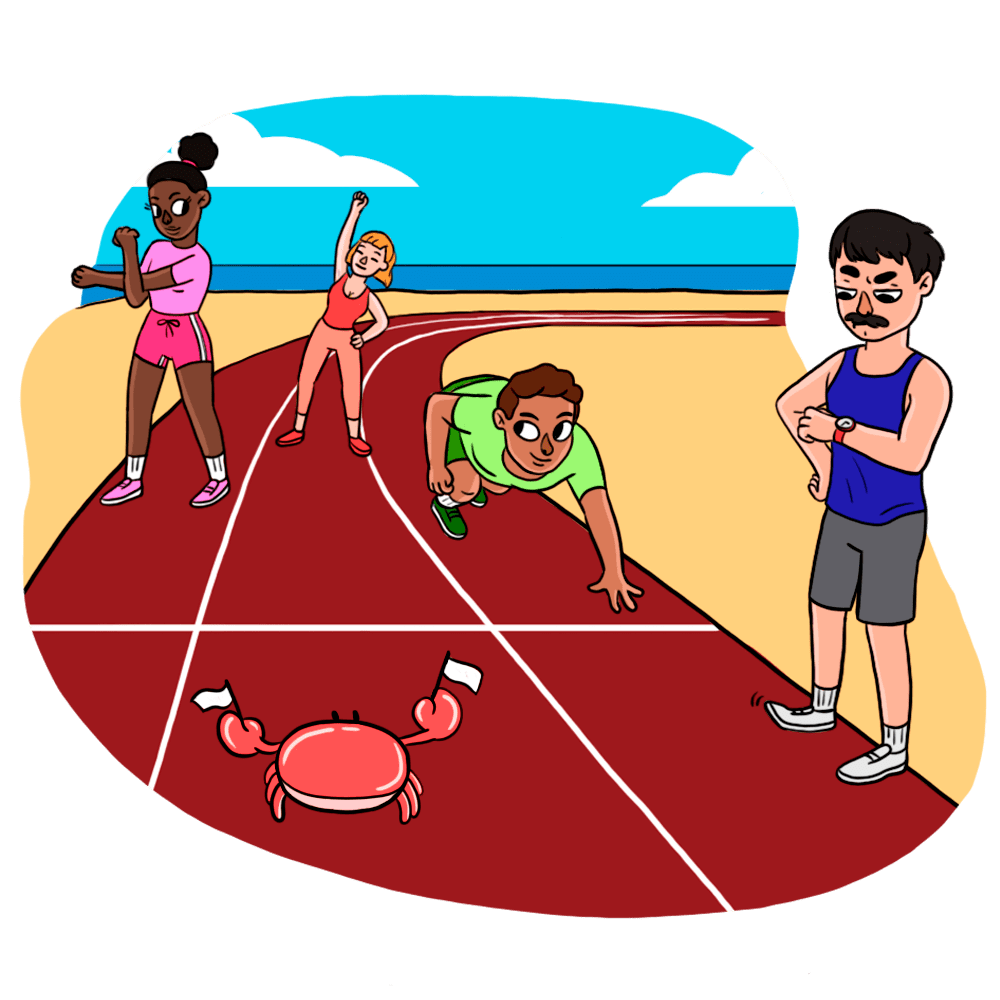
Feature #9

Plan new Sprints with your team like a Scrum Master right from Slack
A sprint is a fixed period during which all the work is done. But before you start to act, you need to plan a sprint. For this, you need to determine the sprint's duration and goal and the work's starting point.
Sprint planning is a Scrum ritual that determines the amount of work for the next sprint and how to complete this work best.
Sprint planning is a Scrum ritual that determines the amount of work for the next sprint and how to complete this work best.
Our template "Team Goals" will help you set goals correctly. But to plan your sprint use our new template Sprint Planning. Now you can do this right in Slack, clearly, quickly, and without extra information.
Setting up Sprint Planning with Standuply
1. Choose "Sprint Planning" template and let's roll!


2. Choose respondents, CRM system and set a questions for your team.


See how it looks like in Slack:
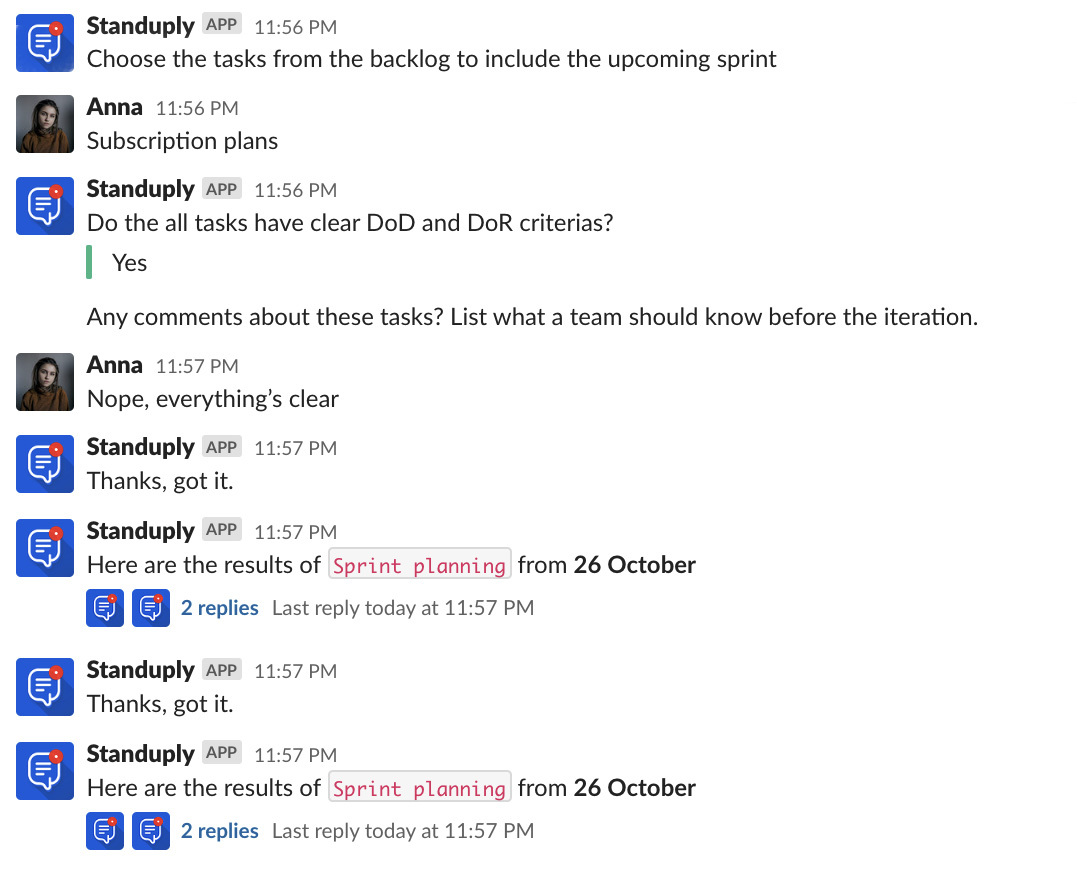

Feature #10
Set your team goals as guru from Slack avoiding annoying micromanagement
Setting Sprint Goals is essential for a Scrum team and an integral part of project management.
Agile Teams plan their work using tasks ('stories') that are small enough to be completed in a single iteration. Ideally, the combination of all the stories is a concrete deliverable ('sprint goal').
Project management helps teams complete their goals in a timely fashion. Sprint Goals help in understanding and maintaining a broader view of what the team intends to accomplish in each Sprint. Goals set to keep the team clearly focused and acts like a North Star showing the chosen way.
Sprint goals are fundamental for transparency and team alignment. Ideally, the team understands the business value of each iteration and its goal. The most experienced product owners not only set goals but also explain their business purpose.
During the sprint, the team doesn't need to discuss the goals (and, ideally the goals don't change during a Sprint). It's enough to remind the team of the goals to keep everyone on the same page. A successful sprint is one that has achieved its goal.
Agile Teams plan their work using tasks ('stories') that are small enough to be completed in a single iteration. Ideally, the combination of all the stories is a concrete deliverable ('sprint goal').
Project management helps teams complete their goals in a timely fashion. Sprint Goals help in understanding and maintaining a broader view of what the team intends to accomplish in each Sprint. Goals set to keep the team clearly focused and acts like a North Star showing the chosen way.
Sprint goals are fundamental for transparency and team alignment. Ideally, the team understands the business value of each iteration and its goal. The most experienced product owners not only set goals but also explain their business purpose.
During the sprint, the team doesn't need to discuss the goals (and, ideally the goals don't change during a Sprint). It's enough to remind the team of the goals to keep everyone on the same page. A successful sprint is one that has achieved its goal.
Setting up Sprint Goals with Standuply
Choose the 'Team Goals' template and let's move on. It serves as a reminder for a manager to share the goals with the team.


Configure the schedule according to your workflows. On the second step, select people to ask who is responsible for the goals and set up the corresponding questions. You'll see our example prefilled.
See Team Goals feature and Team Performance webpages on Standuply!
See Team Goals feature and Team Performance webpages on Standuply!

See how it looks like in Slack:

OKR Planning and Checkup
OKR or "Objectives and Key Results" is a project management technology for planning and achieving goals that have become famous thanks to Intel and Google.
OKR represents an ambitious goal and several measurable actions that need to be taken to achieve this goal.
This method is usually used for setting goals for the next quarter, but it can also be used for annual planning. The bottom line is that there should be several metrics for each given goal to show how much the goal has been achieved.
OKR represents an ambitious goal and several measurable actions that need to be taken to achieve this goal.
This method is usually used for setting goals for the next quarter, but it can also be used for annual planning. The bottom line is that there should be several metrics for each given goal to show how much the goal has been achieved.
Setting OKR Tracking with Standuply
We have two report templates for OKR tracking: OKR Planning and OKR Checkup. Let's examine both of them.


1. Choose OKR planning report and set up the questions. As always, we've prefilled the template for you, but you can customize it as you want.

See how it looks like in Slack:
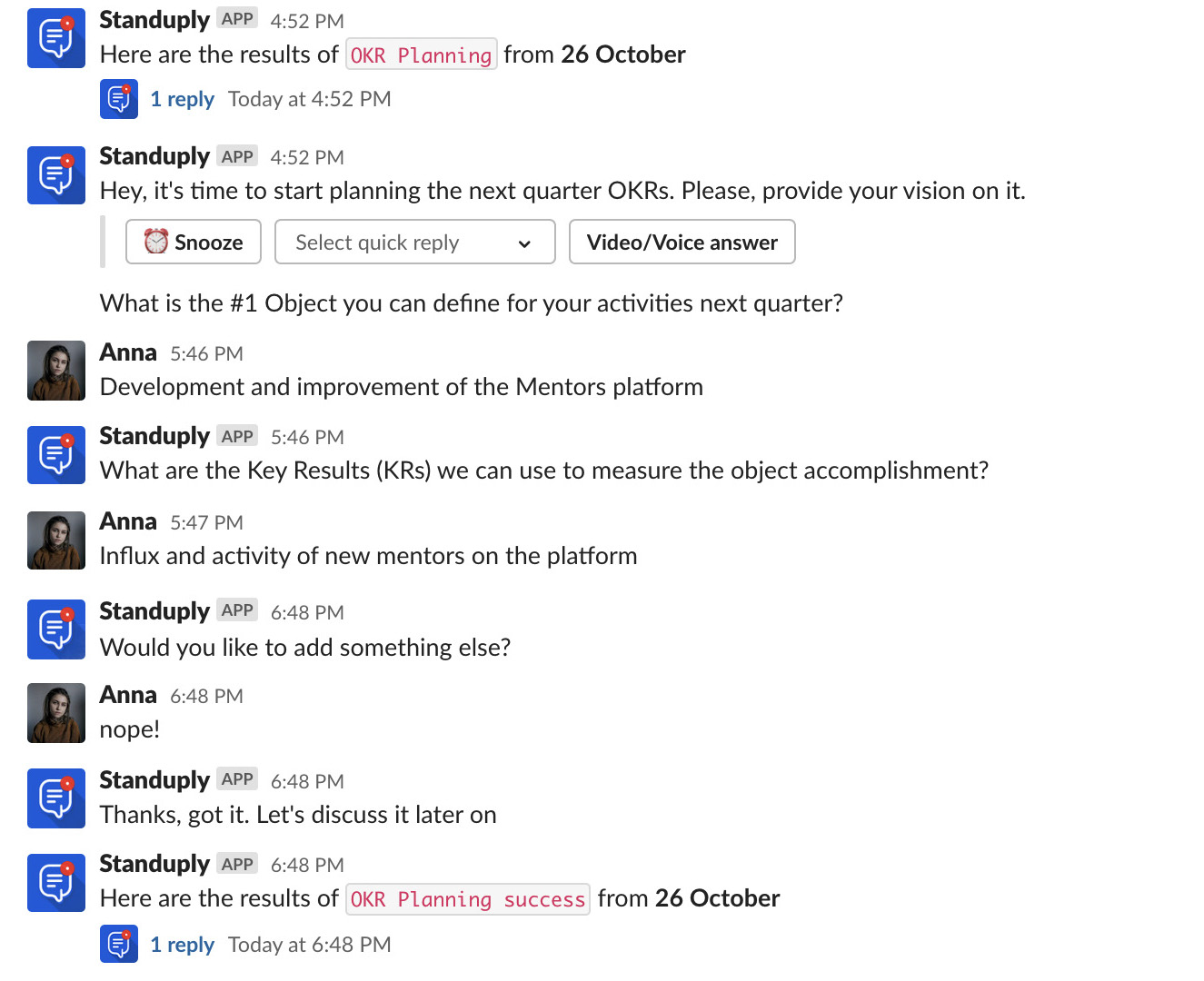

Feature #11

Now you can track your team's sales progress directly from Slack!
A daily sales stand-up meeting is a mandatory meeting that is usually held every day with the entire sales team. These daily standups are used to provide accountability for activities.
Daily sales standups are best used with teams that estimates on such metrics as outgoing calls, sent emails, or conversation time.
Daily sales standups are best used with teams that estimates on such metrics as outgoing calls, sent emails, or conversation time.
Setting up Sales Standup with Standuply
We have two report templates for your sales team. Sales standup is a classic standup report with sales team-oriented questions. Advanced sales standup is more complex. It's the report template that requires integration with your CRM. So let's take a closer look at the second one.
1. First find Advanced sales standup report in Standuply, set the schedule and pick respondents.



2. Then you need to select a task tracker.
Standuply supports Hubspot integration out of the box, so if your team uses it, you are able to run standup process focused on your certain assigned deals in CRM. We also have integrations with JIRA, Trello, Asana, GitHub, and Pivotal, or you can also integrate your own CRM by yourself using Custom Endpoint.

See how it looks like in Slack:

Set your time management right from Slack as a super-pro now!
Each team decides whether it's needed for them to log in the time spent on tasks or not. In offshore development, it's a must.
Scrum teams log in story points rather than time. But if the team tracks time, everyone should log in all their work done.
Scrum teams, for example, can draw a Burndown chart and foresee when exactly all the work will be done. It can be done only when all story points are submitted in time. So, consistency makes or breaks this process.
It's always about the manager to convey the importance of that process and check whether it's in place. That's why there are so many time tracking apps out there.
Scrum teams log in story points rather than time. But if the team tracks time, everyone should log in all their work done.
Scrum teams, for example, can draw a Burndown chart and foresee when exactly all the work will be done. It can be done only when all story points are submitted in time. So, consistency makes or breaks this process.
It's always about the manager to convey the importance of that process and check whether it's in place. That's why there are so many time tracking apps out there.
Setting up Time Tracking with Standuply
To track time chose the 'Time tracking' template in Standuply. It serves as a reminder for your team to log in their work.


First define a schedule and then select people from your team. In the question field, you can add a link to a place where you log in work hours.

See how it looks like in Slack:

That's it!
With Standuply you can easily transform Slack into a perfect project management tool and forget about micromanagement routine.
With Standuply you can easily transform Slack into a perfect project management tool and forget about micromanagement routine.
We often update this guide, but even more often we release new features. If you haven't found a description of some processes let us know in the comments below
or contact our support team!
or contact our support team!

Get the whole guide in a PDF file to read it later.
Enter your email where you want us to send it.
Enter your email where you want us to send it.
We never spam or sell your data. By clicking you agree to our Privacy Policy.















